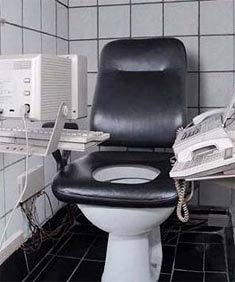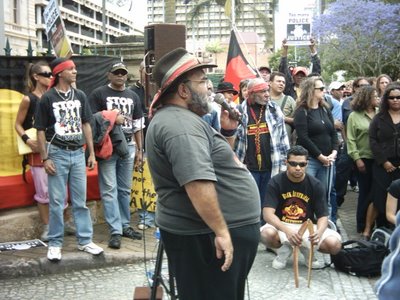*West End is an inner suburb of Brisbane, Australia. Boundary St. is West End's main street. It was named Boundary St. in the time when Brisbane was segregated between black areas and white areas.

The old Boundary St. public toilet before demolition(above).

The new redeveloped public toilet that incorporates tenancy advice, a health service and public internet access.
Here is the nearly absolutely accurate modern history of the public toilets in Boundary Street, the community notice boards in Boundary Street and the West End Community house.
In the late 70's, when I first to came to West End, the old toilet block in Boundary St. was a pretty standard brick and tiled public toilet. At the beginning of the 80's West End was the home turf of Brisbane's Aboriginal street kids, often called "glueies" at the time because they sniffed glue like a lot of people sniff paint today. Glue does not provoke such intense violence or psychosis as paint, so the glueies were not like today's chromers at all. Anyway, these young people developed a habit of graffitti. How many oldies remember the famous "Couchie" art movement? The toilet of course was constantly redecorated by these artists, that is until proffessional Aboriginal artists were paid to put a mural on the toilet. These proffessional artists were known by, respected by and in many cases related to the street kids. The mural became one of the few places where you could not find Aboriginal graffiti. Unfortunately local NAZIs did not have such respect and the mural still attracted their graffiti.
At the time of the first toilet mural, South Brisbane was the epicentre of urban Aboriginal Queensland, maybe even Australia. Many local and national Aboriginal organisations were based here and many local homes were inhabited by Aboriginal people. These proud organisations and homes defined Aboriginality and built local community in it's image..
A short time after that, a group of un-named drunken anarchists took it upon themselves to graffiti a tobacco add that used to be at street level on the corner of Boundary and Vulture Streets. The advertising company was very efficient and determined and the graffitti was allways replaced by a new ad within 24 hours. The anarchists were neither efficient nor determined, but they did drink every day and allways graffitied the add again within the next 24 hours. This went on for a while and the party animals got bored doing the same thing all the time. They then started covering the tobacco add with plain butchers paper and wrote on the top "community notice board". This went on for a while too, but other people started putting notices on the board in between tobacco adds, so the drunks were still getting a good giggle and kept doing it. One day, when the communication commandos turned up to "fix" the ad, someone else had beaten them to it. One day the tobacco add dissappeared completely. Success we thought........ I mean, "they" thought. The tobacco giant had been beaten on the corner of Boundary and Vulture. But this became a hollow victory as it also meant no more community notice board. So the bare brick wall on the optometrist where the tobacco add used to be became the community notice board instead. This also got cleaned up frequently by the council until they too gave up and installed the first official community notice board in West End. Hooorrahhhh!!!! But that's not all! Emboldened by their victory over corporate giants and the apparatus of the state, the anarchists did the same on the wall behind the public toilets. The devious council tyrants then put an official notice board next to the toilets, causing the underground notice board revolution to lose direction and drift into history.
Later the council called the grass around the toilet a "park". -Former Lord Mayor Sallyanne Aitkinson, (who looked beautiful beside the toilet), officially named it the community park at a moving ceremony. The day before, the Anarchist officially named the park the "Peoples Park" at their own ceremony, and held an anti-expo88 protest at the Lord Mayor's ceremony. More recently the grass has become known as "Little Musgrave" or "Small Park"
The West End Uniting Church also has a fascinating history, most of it before my time though. Oodgeroo Nunukul was married there. Many of us know of Dr.Noel Preston from his work with justice and ethics. His father was a famous and powerful evangalist who built a local christian congragation at Sussex St. that outgrew the church and had to move to the Rialto theatre.
in the late 1970's West End was an impoverished community and had few and substandard community services. Rev. Lin Reilly from the Uniting Church was at the time a social worker, university lecturer and church minister. He decided to have a go at making West End better. He used to get his U.Q. students to do research in West End for his courses At the age of 18 or 19 and a university drop-out I was "supervising" 2 of his postgraduate students in a West End community garden and work co-op as part of this process. He then applied to government for every last cent he could to set up local welfare projects including West End Community House, the church kindergarten, the Blue Nurses, and a range of other programs. He also highlighted deficiencies in programs already here such as the maternal and Child welfare agency and lobbied for their upgrading. The very first no-dig community garden in West End was developed behind the Dornoch Tce, Catholic Church through this process.
Anyway, despite the churches rich heritage, its numbers and enthusiasm declined from the seventies on. It maintained ownership of West End Community house but basically let it blow in the wind with the local community since before expo 88. The church however often spoke of it's support of community house in terms of Christian mission. Now this is where it gets funny. When Community House was in the Sussex St. complex, the Queensland Uniting Church property department (not the local congregation) was negotiating with Coles to demolish the church and neighboring houses to put up a supermarket. This was only stopped because of local, non-church, protests. The plan changed to put Coles where it is now. A few years before that, the church evicted the "Bodyworks" community youth program (where I used to work) and "Street Arts" who were national and local pioneers in community theatre, from their hall in Hill End. The church sold it to a private company. This was , the same hall that hosted Pastor Don Brady's "Rock Masses" in the 1970's..
More recently Community House moved to Norfolk St. (just behind Coles) and employed a housing worker to work, in particular, with displaced local people. At the same time the Church property department evicted pensioners, against their will, from one of their large unit blocks in West End in order to renovate and sell it. - Funny eh?
West End Community House was given it's independence from the church recently. It has also come to manage the 4AAA Kurilpa kiosk - the featured eastern wing of the new toilet complex.
Community House has strong connections to local politicians, including board membership. It is primarily funded through state govt. money. Because of this, many of the contradictions of church management still exist with government funding and property development agendas. For example, the state government and the council are managing Brisbanes biggest property development project, - "the cultural precinct" including the Millenium Arts Centre which happens to be in our community.. This will continue to escalate local property values and smash the homeless community that now inhabit Kurilpa point and surrounds. It is doing the same thing that Expo 88 did. The state government and the church have both been a powerful counterbalance to the good work Community House tries to do, similarly the church and the government have both taken credit for supporting the disadvantaged through their connection to Community house as funders or directors..
So, Community House brings us back to the public toilets, the community notice board, the Kurilpa kiosk and now the next epoch in the toilet's evolution, the snake. Today, because of the kurilpa kiosk, and the new mural, the toilet block has become the local symbol of Aboriginality - a long way from South Brisbane's "Black Power" days when the Aboriginal medical, legal and housing services and Musgrave Park did this and the toilet was the turf of the street kids.. There are not many murries left in West End any more, and of those who are still living here they frequently get chased out of the toilet park by the police. I prefered the graffitied old toilet because at least it was a reminder that this is Aboriginal land, and of the capacity of local Aboriginal organisations of the time. Today the toilet tells a different story, one of desperation, tokenism and cultural devaluation. Marshall Mcluhan said, and I agree, "The medium is the message". There is a clear messages about West End by developing an Aboriginal identified place under the auspice of a toilet.
Fortunately there is Musgrave Park. Despite the decades of non-development of the Aboriginal cultural centre and the councils unwillingness to put up even basic shelter sheds or appropriate facilities, Musgrave still stands as a proud and defiant Aboriginal space, unconcerned for the sensitivities of what white people might think.
Always was, always will be - Aboriginal land, all of it, not just the public toilet.








 With my recent curiousity about blogging it is appropriate that I tell you about Senator Andrew Bartlett's blog. Andrew is getting a lot of attention lately for being the first and the best blogging politician in Australia.
With my recent curiousity about blogging it is appropriate that I tell you about Senator Andrew Bartlett's blog. Andrew is getting a lot of attention lately for being the first and the best blogging politician in Australia.

